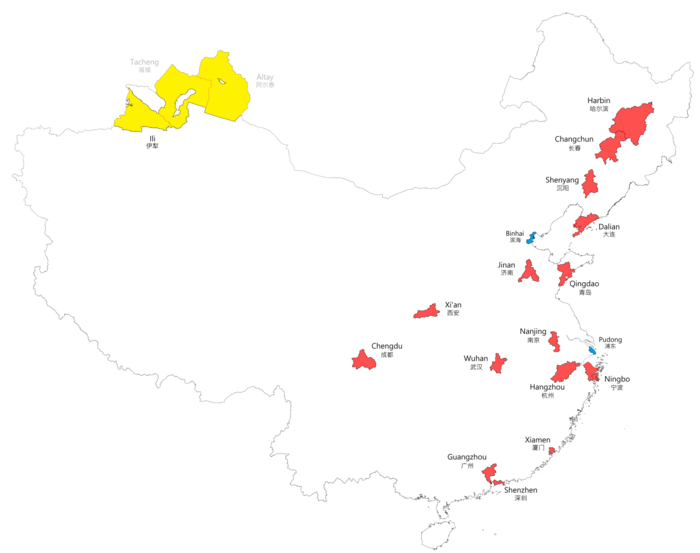A sub-provincial division (Chinese: 副省级行政区; pinyin: Fùshěngjí xíngzhèngqū) in China is a prefecture-level city governed by a province promoted by half-a-level. Thus, it is half-a-level under the provincial level, and half-a-level above the prefecture-level, hence the name "sub-provincial".
The promotion applies to all its subdivisions, administrative institutions, and political parties. For example, the mayor of a sub-provincial division is equal in status to a vice-governor of a province.
A sub-provincial division is still administratively governed by a province, just like prefecture-level divisions. However, five of them are also cities specifically designated in the state plan (Chinese: 计划单列市 / 計劃單列市), which enjoy the provincial level authority over economic issues—governmental finance, customs, economic strategy planning, economic policy, foreign economic affairs, banking, etc.
Sub-provincial divisions, similar to prefectural-level divisions, are administrative units comprising, typically, a main central urban area (the core city) surrounded by rural area, which together are divided into districts, and some surrounding counties or county-level cities (all promoted to sub-prefecture level) governed by the sub-provincial division on behalf of the province, which all have their own urban areas surrounded by their own rural areas.
|
Map of Sub-provincial level entries in China
 |
Sub-provincial municipalities
The original 16 municipalities were renamed as the sub-provincial municipalities on 25 February 1994 by the Central Organization Committee out of the prefecture-level municipalities.[1] They are mostly the capitals of the provinces in which they are located.
Currently, there are 15 sub-provincial municipalities after Chongqing was designated direct-control:[2]
More information Division name, Simplified Chinese ...
Sub-provincial municipalities of China[3]
| Division name |
Simplified Chinese |
Hanyu Pinyin |
Province |
Abbreviation |
Region |
Population (2010 Census) |
Date of designation |
Subdivision |
| Changchun |
长春市 |
Chángchūn |
Jilin |
长 |
Northeast |
7,677,089 |
1989-02-11 |
7 districts, 2 county municipalities & 1 county |
| Chengdu |
成都市 |
Chéngdū |
Sichuan |
蓉 |
Southwest |
14,047,625 |
1989-02-11 |
11 districts, 4 county municipalities & 5 counties |
| Dalian |
大连市 |
Dàlián |
Liaoning |
连(鲲) |
Northeast |
6,690,432 |
1984-07-13 |
7 districts, 2 county municipalities & 1 county |
| Guangzhou |
广州市 |
Guǎngzhōu |
Guangdong |
穗 |
South Central |
12,700,800 |
1984-10-05 |
11 districts |
| Hangzhou |
杭州市 |
Hángzhōu |
Zhejiang |
杭 |
East |
8,700,400 |
1994-02-25 |
10 districts, 1 county municipality & 2 counties |
| Harbin |
哈尔滨市 |
Hā'ěrbīn |
Heilongjiang |
哈 |
Northeast |
10,635,971 |
1984-10-05 |
9 districts, 2 county municipalities & 7 counties |
| Jinan |
济南市 |
Jǐnán |
Shandong |
济 |
East |
6,814,000 |
1994-02-25 |
7 districts & 3 counties |
| Nanjing |
南京市 |
Nánjīng |
Jiangsu |
宁 |
East |
8,001,680 |
1989-02-11 |
11 districts |
| Ningbo |
宁波市 |
Níngbō |
Zhejiang |
甬 |
East |
7,605,689 |
1987-02-24 |
6 districts, 2 county municipalities & 2 counties |
| Qingdao |
青岛市 |
Qīngdǎo |
Shandong |
胶 |
East |
8,715,100 |
1986-10-15 |
7 districts & 3 county municipalities |
| Shenyang |
沈阳市 |
Shěnyáng |
Liaoning |
沈 |
Northeast |
8,106,171 |
1984-07-11 |
10 districts, 1 county municipality & 2 counties |
| Shenzhen |
深圳市 |
Shēnzhèn |
Guangdong |
深(鹏) |
South Central |
10,357,938 |
1988-10-03 |
8 districts (4 new districts) |
| Wuhan |
武汉市 |
Wǔhàn |
Hubei |
汉 |
South Central |
9,785,392 |
1984-05-21 |
13 districts |
| Xi'an |
西安市 |
Xī'ān |
Shaanxi |
镐 |
Northwest |
8,467,837 |
1984-10-05 |
11 districts & 2 counties |
| Xiamen |
厦门市 |
Xiàmén |
Fujian |
鹭 |
East |
3,531,347 |
1988-04-18 |
6 districts |
Close
Chongqing was formerly a sub-provincial municipality of Sichuan until 14 March 1997, when it was made an independent municipality by splitting it out of Sichuan altogether. The Xinjiang Production and Construction Corps also has the powers of a sub-provincial division.
Chengdu is the largest sub-provincial municipality. It has a population exceeding that of the independent municipality of Tianjin while both Harbin and Chengdu have a bigger land area than Tianjin.
In total, there are five sub-provincial municipalities that are not themselves provincial capitals. These five municipalities have been designated as the "Municipalities with Independent Planning Status" (simplified Chinese: 计划单列市; traditional Chinese: 計劃單列市; pinyin: Jìhuá Dānliè Shì).
Sub-provincial autonomous prefecture
Ili Kazakh Autonomous Prefecture has the two prefectures of Altai and Tacheng and 11 directly-controlled county-level administrative divisions under its jurisdiction. It itself is legally only a prefecture-level division, which is a special case in China's administrative divisions. It is not accurate to regard Ili Kazakh Autonomous Region as a sub-provincial administrative division, which has no legal basis. Up until 2001, the Autonomous Prefecture had a 3rd prefecture as well. The directly controlled subdivisions were administered as part of Ili Prefecture (伊犁地区)
More information Division name, Simplified Chinese ...
Close
